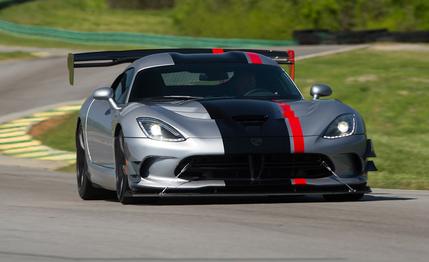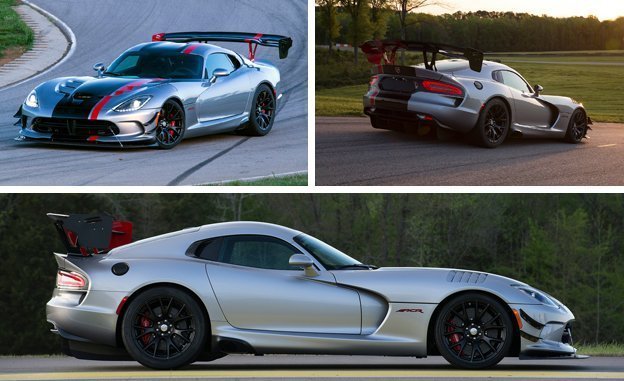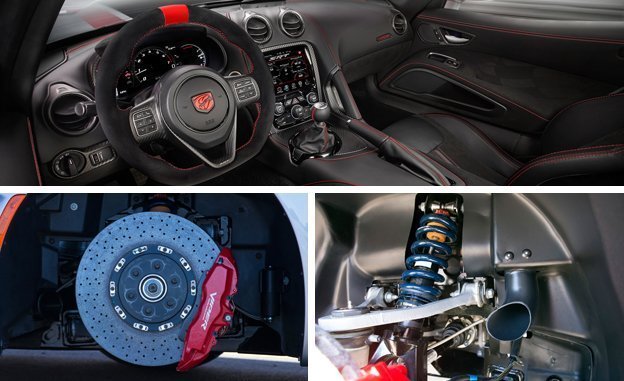 First Drive Review
First Drive Review
The 2016 Dodge Viper ACR is the fastest Viper around a racetrack—at least that’s what Dodge claims—but a 177-mph top speed makes it the slowest Viper. With the exception of a finned differential for cooling, the ACR’s drivetrain is identical to that found in the rest of the Viper lineup. That means an 8.4-liter V-10 that throbs out 645 horsepower and 600 lb-ft of torque and looks to be about the size of a steamer trunk. What makes the Viper ACR faster around a racetrack is also what reduces its straight-line speed—downforce.
Downforce uses air for the very noble purpose of pushing a car down into the earth. The harder the air pushes the car into the tarmac, the faster the car can corner. But downforce also creates aerodynamic drag, which slows down a car at the top end. Imagine an upside-down set of airplane wings strapped to the roof of a Viper and you have a decent idea of how it works.
By default, a huge adjustable wing is bolted to the Viper ACR’s trunklid, a massive front splitter gives the car an underbite, the front bumper is flanked by a dive-plane moustache, fender vents perched above the front tires reduce lift, and a rear diffuser cuts the air like a mandolin slicer. Opt for the ACR Extreme package, however, and the wing, splitter, and diffuser all grow, making them even more effective and pushing the ACR harder into the asphalt—to the tune of 2000 pounds of downforce at its 177-mph top speed. The penalty comes in terms of the stated drag coefficient, which is 0.54 for the ACR Extreme versus 0.37 for the regular Viper SRT and 0.43 for the Viper TA.
We drove the Viper ACR Extreme at Virginia International Raceway a month after conducting the ninth iteration of our Lightning Lap test on the same premises, the results of which will be published in the coming weeks. We didn’t get to time our laps or record any telemetry, but we’re confident that the ACR is several seconds quicker around the 4.1-mile-long course than the Viper TA we tested for Lightning Lap at VIR last year, a car that ran a 2:49.9.

Although the aerodynamic package is a major component of what makes the ACR what it is, there are other new pieces of hardware included in the car’s $122,490 MSRP. Larger carbon-ceramic brakes that measure 15.4 inches (1.4 inches larger than before) with six-piston calipers in front necessitated bigger, 19-inch front wheels (one inch larger than standard). The rear wheels hide 14.2-inch carbon-ceramic rotors with four-piston calipers.
To make the most of the downforce and the braking power, the ACR wears new tires developed specifically for this application. Development on the rubber started two years ago, which is when Dodge approached Kumho; the result is the Ecsta V720. A near slick, the Kumhos have a few superficial grooves molded into them to make them nominally street-legal. The rear tires remain sized 355/30R-19, but while the front tires are the same 295 width as on other Vipers, they have a section height of 25 against the regular car’s 30s.
The coil-over suspension features radically stiffer springs with height-adjustable perches, as well as adjustable shocks that can be tuned for rebound and jounce. What we noticed at VIR is that the ACR is more stable, less prone to spastic leaps off the curbs, and easier to drive fast than the TA we lapped last year.
For one, the ACR doesn’t react to every steering-wheel movement with the jerk of a leg that’s been hit in the knee with a rubber mallet. It’s much slower to nose into a corner, possibly too slow. To show the adjustability of the ACR, Dodge engineers on hand dialed back the rear wing slightly and removed the front fender louvers. We didn’t have a lot of laps with the new setup, but it did gain some front-end grip. Again, we couldn’t quantify anything, but suddenly we felt like we could turn in with more accuracy and that we weren’t going fast enough in VIR’s many long, sweeping corners.

On the long straight, the winged ACR hit an indicated 147 mph going into the braking zone. In the wingless Viper TA we saw 152.1 mph. With less speed on the straight, the ACR’s grippier tires and huge binders allowed us to brake later and with greater confidence. We did notice that the nose would dive enough to plow the front splitter into the tarmac when braking hard into one uphill section of the track. Brake as hard as you want, though, as the splitter is designed to be easily replaceable.
But don’t get the idea that the ACR is an easy car to drive quickly. It’s definitely worthy of its Viper name, and it takes a lot of laps to get used to the ACR’s grip. Going fast requires a few things of the driver: The car wants to be pointed straight when you’re hard on the brakes or the tail will wag, the shifter still needs to be strong-armed into gear, and making meaningful downforce requires big speed. At VIR, the big speed is demanded of you in the most pucker-intensive corners of the track. But it’s the speed and the cornering limits that are daunting; the car’s behavior is predictable as long as you don’t do anything stupid.
Dodge is selling a race car that you can put a plate on. It might be street-legal, but we can’t tell you what the Viper ACR was like to drive on the road—Dodge kept us on the track with the ACR, a clear indication of its mission. Driving it among Nissan Versas and the like would have been frustrating, because going slow on a track is still more fun than trying to find ways to go fast on the street. In much the same way that this “slower” ACR is more fun than its “faster” Viper brethren.